مقدمة
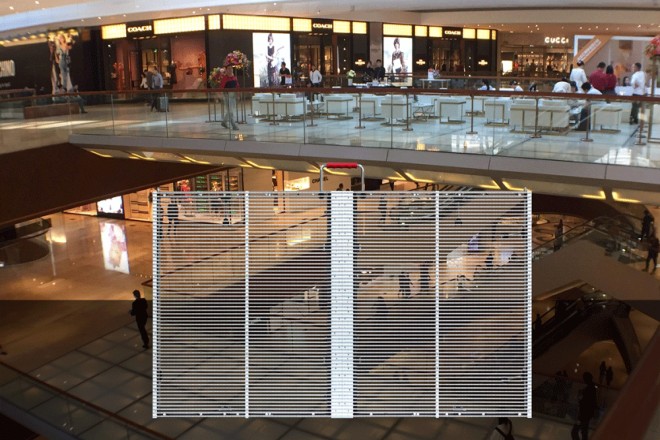
شاشات عرض LED شفافة، بتأثيراتها البصرية الشفافة الفريدة وأدائها الممتاز، تقود اتجاهًا جديدًا في مجال العرض التجاري والإعلان.
مع انتشار استخدامها، أصبح استكشاف الأخطاء وإصلاحها وصيانتها أمرًا بالغ الأهمية لضمان استقرار التشغيل. تهدف هذه المقالة إلى تحليل الأعطال المحتملة وأسبابها في شاشات عرض LED الشفافة بشكل معمق، وتقديم حلول فعّالة.
1. ظهور ظلال على شاشة عرض LED الشفافة
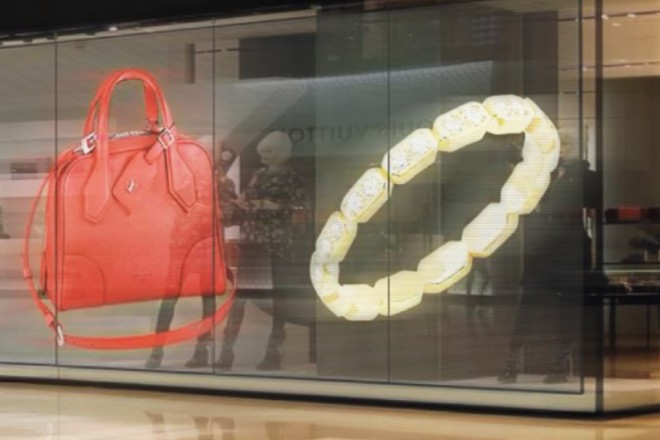
عند مشاهدة الصور أو مقاطع الفيديو على شاشة عرض LED شفافة، إذا وجدت أن حواف الصورة أصبحت غير واضحة، كما لو كان هناك ظلين أو أكثر متداخلين، فهذه هي ظاهرة ما يسمى بـ "الظلال".
يؤدي ظهور الظلال إلى صعوبة التعرف على المحتوى المعروض ويؤثر على تجربة المشاهدة.
1) تحليل السبب
- ال معدل التحديث ليس سريعًا بما فيه الكفاية:
يشير معدل التحديث إلى عدد مرات تحديث الشاشة للصورة في الثانية. إذا كان معدل التحديث منخفضًا جدًا، فستبقى الصورة على الشاشة، مشكلةً شبحًا، تمامًا كما لو كنت تشاهد فيلمًا قديمًا إطارًا تلو الآخر.
بالنسبة لشاشات LED الشفافة، يجب أن يكون معدل التحديث مرتفعًا بدرجة كافية لضمان صور سلسة بدون ظلال.
- يتداخل نقل الإشارة مع:
في عملية نقل الإشارة من المصدر إلى شاشة العرض، قد تتداخل مع عوامل خارجية مختلفة، مثل المجالات الكهرومغناطيسية والموجات الراديوية وما إلى ذلك. ستؤدي هذه التداخلات إلى عدم استقرار الإشارة، مما يؤدي إلى ظهور ظلال على الشاشة.
- مشكلة شريحة السائق:
شريحة التشغيل بمثابة دماغ الشاشة، فهي مسؤولة عن استقبال الإشارات والتحكم في تشغيل وإطفاء مصابيح LED لعرض الصور. في حال تعطل شريحة التشغيل أو تهالكها، سيؤدي ذلك إلى نقل إشارات غير دقيقة، مما يؤدي إلى ظهور ظلال على الشاشة.
2) الحل
- زيادة معدل التحديث:
إذا كان سبب التشويش هو عدم كفاية معدل التحديث، يمكنك محاولة ضبط إعداد معدل تحديث الشاشة. بشكل عام، كلما ارتفع معدل التحديث، كانت الصورة أكثر سلاسة وتقلّ التشويش.
- التحقق من إرسال الإشارة:
في حال تداخل نقل الإشارة، يُمكنك التحقق من سلامة توصيل خط الإشارة وخلوه من أي تداخل خارجي. إن أمكن، يُمكنك استخدام أسلاك مُغطاة أو مُعدّات مُضادة للتداخل لتقليل التداخل.
- استبدال شريحة السائق:
إذا تبيّن وجود مشكلة في شريحة التشغيل، فيجب استبدالها بأخرى جديدة. قد يتطلب هذا الأمر فنيين متخصصين، لأن استبدال شريحة التشغيل يتطلب دوائر معقدة وأعمال لحام.
2. جزء من شاشة العرض LED الشفافة لا يعرض
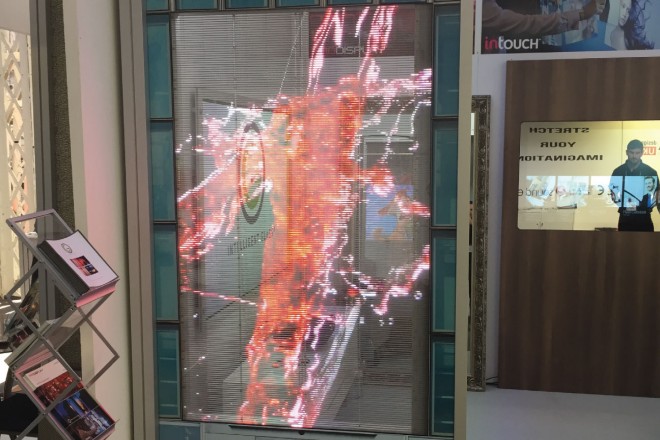
عندما تستمتع بالمحتوى الرائع على شاشة العرض LED الشفافة، فجأة، تصبح زاوية أو منطقة من الشاشة باهتة كما لو كانت "محمية"، بينما لا تزال الأجزاء الأخرى معروضة بشكل طبيعي.
هذه الظاهرة المتمثلة في عدم العرض الجزئي هي مشكلة "عدم العرض الجزئي لشاشة العرض LED الشفافة" التي سنناقشها اليوم.
1) تحليل السبب
- غير كافية أو متقطعة مزود الطاقة:
تتكون شاشة العرض LED الشفافة من العديد من الأجزاء الصغيرة وحدات LEDوتتطلب كل وحدة مصدر طاقة ثابت لتشغيل الضوء الخاص بها.
إذا كان مصدر الطاقة لوحدة أو منطقة غير كافٍ، أو تم قطعه ببساطة، فلن تعمل الوحدة بشكل صحيح، مما يؤدي إلى ظهور "شاشة سوداء" على الشاشة.
- اتصال كابل البيانات ضعيف:
يعتبر كابل البيانات بمثابة "الشبكة العصبية" لشاشة العرض، وهو المسؤول عن نقل الإشارة المرسلة من بطاقة التحكم إلى كل وحدة.
إذا كان كابل البيانات فضفاضًا أو مكسورًا في مكان ما، أو إذا كان الاتصال ضعيفًا بسبب الغبار أو الأوساخ وما إلى ذلك، فلن تتمكن الإشارة من الوصول إلى وحدة معينة بسلاسة، ولن تتمكن الوحدة من العرض بشكل طبيعي.
- بطاقة التحكم معيبة:
بطاقة التحكم هي وحدة التحكم الرئيسية لشاشة LED الشفافة. وهي مسؤولة عن معالجة البيانات من جهاز الكمبيوتر أو أي مصدر إشارة آخر، وتحويلها إلى إشارة تفهمها الشاشة.
في حالة فشل بطاقة التحكم، مثل اضطراب البرنامج أو تلف الأجهزة وما إلى ذلك، فقد لا تتمكن من إرسال الإشارات بشكل صحيح، مما يؤدي إلى عدم قدرة بعض المناطق على استقبال الإشارات وعدم عرضها.
2) الحل
- فحص وإصلاح مصدر الطاقة:
أولاً، يجب فحص مصدر طاقة الشاشة. تأكد من استقرار مصدر الطاقة في كل وحدة أو منطقة، وعدم وجود أي انقطاع أو نقص في الطاقة بسبب تقادم كابل الطاقة أو ضعف التوصيل، وما إلى ذلك.
إذا تم العثور على مشكلة في الطاقة، فأنت بحاجة إلى استبدال سلك الطاقة القديم في الوقت المناسب، أو إصلاح الاتصال الضعيف.
- فحص واستبدال كابل البيانات:
بعد ذلك، عليك التحقق من توصيل كابل البيانات. بدءًا من بطاقة التحكم، افحص كل وحدة للتأكد من أن توصيل كل كابل بيانات متين وموثوق.
إذا تبين أن كابل البيانات فضفاض أو مكسور أو غير متصل بشكل جيد بسبب الأوساخ، فستحتاج إلى استبداله بكابل بيانات جديد في الوقت المناسب، أو تنظيف الأوساخ وإعادة توصيله.
- استبدال أو إصلاح بطاقة التحكم:
إذا استمرت المشكلة بعد خطوتي الفحص والإصلاح المذكورتين، فمن المرجح أن بطاقة التحكم معيبة. في هذه الحالة، يجب عليك الاتصال بفني متخصص وطلب فحص حالة بطاقة التحكم.
في حال تعطل بطاقة التحكم، يجب استبدالها بأخرى جديدة لاستعادة التشغيل الطبيعي للشاشة. يُرجى العلم أنه قبل استبدال بطاقة التحكم، يُفضل الاحتفاظ بنسخة احتياطية من البيانات الأصلية والتأكد من توافق بطاقة التحكم الجديدة مع طراز الشاشة ومواصفاتها وما إلى ذلك.
3. سطوع شاشة LED الشفافة غير متساوٍ
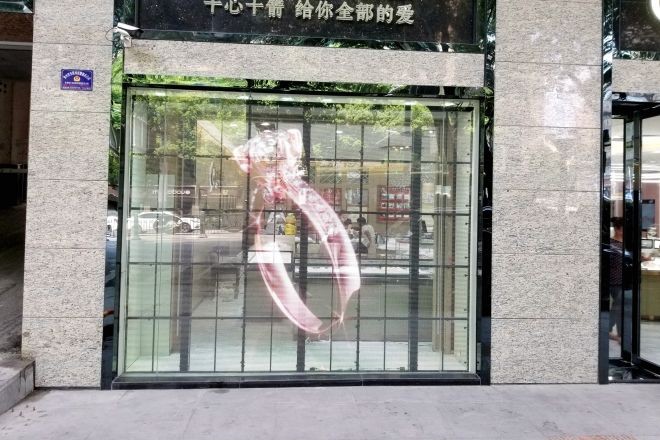
عندما تقف أمام شاشة LED الشفافة، قد تلاحظ أن سطوع الشاشة الإجمالي ليس موحدًا، حيث تكون بعض الأماكن ساطعة بشكل خاص، وبعض الأماكن مظلمة نسبيًا.
لا يؤثر هذا السطوع غير المتساوي على الجمال العام للشاشة فحسب، بل قد يجعل الأشخاص يشعرون بعدم الراحة أو يسبب إجهادًا بصريًا عند المشاهدة.
1) تحليل السبب
- الشيخوخة الطبيعية لخرزات مصباح LED:
تتكون شاشة LED الشفافة من آلاف حبات مصباح LED، والتي سوف تتقدم في العمر تدريجيًا أثناء الاستخدام طويل الأمد.
تمامًا كما تخفت المصابيح الكهربائية في منزلك بعد فترة طويلة من الاستخدام، فإن حبيبات مصباح LED ستتدهور أيضًا في الأداء وتقلل من الكفاءة الضوئية بسبب الاستخدام طويل الأمد، مما يؤدي إلى سطوع غير متساوٍ للشاشة.
- عدم اتساق تيار القيادة:
يتطلب كل مصباح LED تيارًا معينًا لتشغيله. إذا كان تيار التشغيل الذي تستقبله كل وحدة أو مصباح على الشاشة غير ثابت، فسيختلف سطوعها أيضًا.
قد يكون سبب هذا التناقض مشاكل في تصميم الدائرة، أو توزيع الطاقة، أو شرائح التشغيل.
- تراكم الغبار والأوساخ:
يتراكم الغبار والأوساخ بسهولة على سطح وداخل شاشة LED الشفافة. هذه الشوائب تعيق نفاذ الضوء، مما يؤدي إلى انخفاض سطوع الشاشة.
وخاصة عندما يتم توزيع الغبار والأوساخ بشكل غير متساوٍ على سطح الشاشة، فإن ذلك يشكل خطرًا كبيرًا سطوع سيتم تشكيل فرق، مما يجعل الشاشة تبدو مشرقة ومظلمة في قطعة واحدة.
2) الحل
- نظف الشاشة بانتظام:
للحفاظ على سطوع شاشة LED الشفافة، تحتاج إلى تنظيف السطح والجزء الداخلي من الشاشة بانتظام.
استخدم قطعة قماش ناعمة ومنظفًا خاصًا لمسح سطح الشاشة برفق لإزالة الغبار والأوساخ المتراكمة. في الوقت نفسه، افحص الغبار داخل الشاشة بانتظام واستشر فنيًا لتنظيفها.
- ضبط تيار المحرك:
إذا كان سبب تفاوت سطوع الشاشة هو تيار تشغيل غير منتظم، فعليك الاستعانة بفني متخصص لضبط تيار التشغيل لكل وحدة أو خرزة مصباح. بضبط حجم التيار، تستقبل كل خرزة مصباح نفس التيار وتُصدر ضوءًا بنفس السطوع.
- استبدال حبات مصباح LED القديمة:
بالنسبة لخرزات مصابيح LED القديمة جدًا، يجب استبدالها في الوقت المناسب. عند الاستبدال، يُرجى التأكد من اختيار خرزات جديدة بنفس طراز ومواصفات الخرزات الأصلية لضمان التوافق والتأثير الضوئي.
في الوقت نفسه، انتبه إلى التشغيل الآمن أثناء عملية الاستبدال لتجنب إتلاف حبات المصباح أو الدوائر الأخرى.
3) الاحتياطات
بالإضافة إلى الحلول المذكورة أعلاه، يمكنك أيضًا اتخاذ الاحتياطات التالية لتجنب مشكلة عدم تساوي سطوع شاشات العرض LED الشفافة:
- الفحص والصيانة الدورية:
افحص شاشة العرض وصيانتها بانتظام لاكتشاف الأعطال وحلها في الوقت المناسب. يشمل ذلك فحص حالة عمل المكونات الرئيسية، مثل مصدر الطاقة، ودائرة التشغيل، ومصابيح LED، وغيرها.
- استخدم حبات مصباح LED عالية الجودة:
عند شراء شاشات عرض LED الشفافة، اختر حبات مصباح LED ذات الجودة الموثوقة والأداء المستقر.
لا تتمتع حبات المصباح عالية الجودة بكفاءة إضاءة عالية فحسب، بل تتمتع أيضًا بعمر خدمة طويل، مما يقلل من مشاكل الشيخوخة والسطوع غير المتساوي.
- التعديل المعقول للسطوع:
قم بضبط سطوع شاشة العرض بشكل معقول وفقًا لبيئة المستخدم واحتياجاته.
تجنب مشكلة الشيخوخة السريعة لخرزات المصباح والسطوع غير المتساوي الناجم عن استخدام السطوع العالي لفترة طويلة.
وفي الوقت نفسه، يجب علينا أيضًا الاهتمام بتوفير الطاقة وحماية البيئة لتجنب هدر الطاقة غير الضروري.
4. شاشة عرض LED الشفافة تتميز بشفافية منخفضة
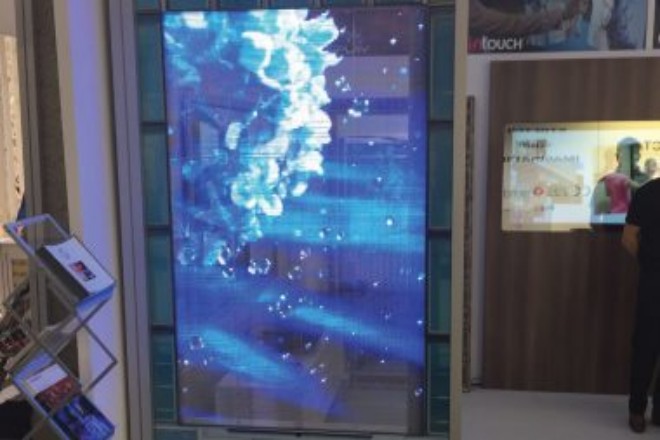
تتميز شاشة العرض LED الشفافة بتصميمها الشفاف الفريد، مما يسمح للمناظر الطبيعية خلفها باستكمال محتوى العرض، مما يوفر تجربة بصرية غير مسبوقة للجمهور.
ومع ذلك، قد تجد أحيانًا أن هذه الشاشة، التي كانت صافية تمامًا، أصبحت أقل شفافية، وأن المشهد خلفها أصبح ضبابيًا أو حتى يصعب تمييزه. هذه هي مشكلة انخفاض شفافية شاشة عرض LED الشفافة.
1) تحليل السبب
- "متسخ" على سطح الشاشة:
تخيل أن تراكم الغبار والأوساخ سيتراكم على نوافذ منزلك إذا لم تُنظف لفترة طويلة؟ وينطبق الأمر نفسه على شاشات LED الشفافة.
قد يلتصق الغبار والشحوم وحتى الجزيئات الصغيرة الموجودة في الهواء بسطح الشاشة، مما يشكل "حاجزًا" يمنع اختراق الضوء ويسبب انخفاضًا في الشفافية.
- "تشوه" البنية الداخلية:
تتكون شاشة العرض LED الشفافة من العديد من المكونات الدقيقة، مثل حبات مصباح LED ولوحات الدوائر وما إلى ذلك. قد يؤدي الاستخدام طويل الأمد أو التأثير بواسطة قوى خارجية إلى تعرض هذه المكونات لتشوه أو إزاحة طفيفة.
كما هو الحال في لعبة الأحجية، إذا فُقدت قطعة واحدة، ستبدو الصورة بأكملها غير متناسقة. هذا التشوه في البنية الداخلية سيؤثر أيضًا على مسار نفاذ الضوء، مما يؤدي إلى انخفاض الشفافية.
- حبات مصباح LED "حرب التخطيط":
تشكل حبات مصباح LED المكونات الأساسية لشاشات العرض LED الشفافة، ويؤثر تخطيطها وترتيبها بشكل مباشر على شفافية الشاشة.
إذا كان تخطيط حبات المصباح كثيفًا جدًا أو كان الترتيب غير معقول، فسيكون الأمر أشبه بجدار محكم الإغلاق، مما يمنع الضوء من المرور.
بالإضافة إلى ذلك، تؤثر كفاءة الإضاءة وتناسق ألوان حبات المصباح على شفافيتها. فإذا كان الضوء الصادر من حبات المصباح غير متساوٍ أو كان اللون متحيزًا، فسيشكل ذلك عائقًا بصريًا واضحًا.
2) الحل
- أعط الشاشة "حمامًا":
من المهم جدًا تنظيف شاشة العرض LED الشفافة بانتظام.
يمكنك استخدام منظفات احترافية وقطع قماش ناعمة لمسح سطح الشاشة برفق لإزالة الغبار والأوساخ العالقة. تذكر، تجنب استخدام قطع قماش خشنة أو مذيبات كيميائية لتجنب إتلاف سطح الشاشة.
- البنية الداخلية "الفحص البدني":
إذا كان سبب انخفاض شفافية الشاشة هو تشوه البنية الداخلية، فيجب طلب فنيين متخصصين لفحصها وإصلاحها.
سيقومون بإجراء فحص شامل لكل مكون داخل الشاشة، واكتشاف المكونات المشوهة أو التالفة وإصلاحها أو استبدالها.
- تحسين "موضع" حبات مصباح LED:
من أجل تحسين شفافية شاشة LED الشفافة، يمكنك التفكير في تحسين تخطيط حبات مصباح LED.
وفقًا للاحتياجات الفعلية، اضبط تباعد وترتيب حبات المصباح لضمان مرور الضوء بسلاسة عبر الشاشة. في الوقت نفسه، من المهم جدًا اختيار حبات مصباح LED ذات كفاءة إضاءة عالية وتناسق ألوان جيد.
3) التدابير الوقائية
- الصيانة الدورية ضرورية:
كما هو الحال مع صيانة سيارتك بانتظام، تحتاج شاشات LED الشفافة أيضًا إلى صيانة دورية. هذا لا يُمكّن من اكتشاف الأعطال وحلها في الوقت المناسب فحسب، بل يُطيل أيضًا عمر الشاشة.
- احرص على تجنب الإصابة:
عند استخدام شاشات LED الشفافة، احرص على العناية بها بعناية لتجنب الصدمات والاندفاعات الخارجية. هذا يمنع تشوه الهيكل الداخلي للشاشة أو تلفه، ويحافظ على شفافيتها.
- التصميم المعقول هو المفتاح:
عند تصميم وتركيب شاشات LED الشفافة، يُرجى مراعاة خصائص شفافيتها بدقة. اختر تصميمًا مناسبًا لخرزات مصابيح LED وكفاءة الإضاءة لضمان شفافية الشاشة.
وفي الوقت نفسه، ينبغي أيضًا مراعاة موضع التثبيت وزاوية الشاشة لتحقيق أقصى استفادة من نفاذية الضوء.
5. شاشة العرض LED الشفافة تومض أو تهتز.
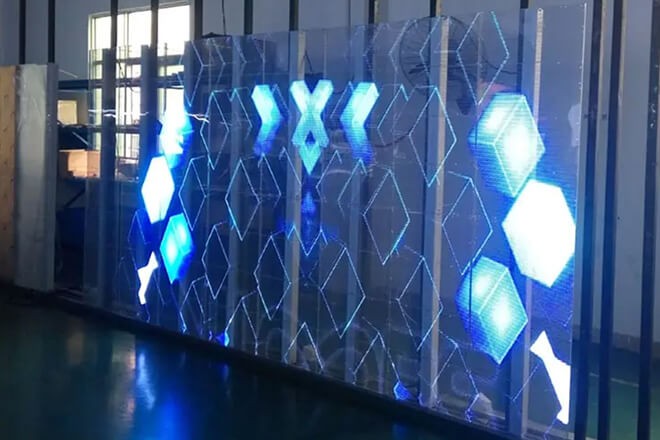
عندما تقف أمام شاشة العرض LED الشفافة، وتتوقع رؤية صورة واضحة ومستقرة، تجد أن الصورة على الشاشة تومض أو تهتز باستمرار، تمامًا مثل مشاهدة فيلم قديم.
لا تؤدي ظاهرة الوميض أو الاهتزاز هذه إلى جعل الأشخاص يشعرون بعدم الارتياح عند المشاهدة فحسب، بل قد تؤثر أيضًا على النقل الدقيق للمعلومات وتقليل تأثير استخدام شاشة العرض.
1) تحليل السبب
- "نبض القلب غير المستقر" لجهد مصدر الطاقة:
تخيل أنك ستشعر بعدم الراحة إذا كان قلبك ينبض بشكل غير منتظم. وبالمثل، تحتاج شاشة العرض LED الشفافة أيضًا إلى جهد كهربائي ثابت للحفاظ على استمراريتها.
إذا كانت جهد مصدر الطاقة يتقلب كثيرًا، فإن ذلك يشبه إعطاء قلب شاشة العرض "صدمة كهربائية"، مما يتسبب في عدم عملها بشكل صحيح، وبالتالي التسبب في الوميض أو الاهتزاز.
قد يكون سبب عدم استقرار جهد مصدر الطاقة هو التقلبات في جهد الشبكة، أو شيخوخة معدات إمداد الطاقة، أو سوء جودة أسلاك إمداد الطاقة.
- "تداخل الضوضاء" في نقل الإشارة:
عندما تتحدث على الهاتف مع صديق، إذا كان هناك الكثير من الضوضاء حولك، فقد لا تتمكن من سماع ما يقوله الطرف الآخر.
وبالمثل، عندما تستقبل شاشة LED الشفافة إشارات، إذا تم التداخل معها بواسطة تداخل خارجي، مثل التداخل الكهرومغناطيسي أو تداخل الموجات الراديوية، فهذا يشبه الكثير من "الضوضاء" المختلطة في الإشارة، مما يتسبب في عدم قدرة الشاشة على تحليل الإشارة بشكل صحيح، وبالتالي التسبب في الوميض أو الاهتزاز.
قد تأتي هذه التداخلات من المعدات الكهربائية القريبة، أو معدات الاتصالات اللاسلكية، أو مصادر كهرومغناطيسية أخرى.
- "ضربة" بطاقة التحكم أو شريحة السائق:
بطاقة التحكم وشريحة التشغيل بمثابة "العقل" و"العضلة" لشاشة LED الشفافة. في حال تعطلها، يفقد الشخص السيطرة والقدرة على التصرف، ولا تعمل الشاشة بشكل صحيح.
بطاقة التحكم مسؤولة عن استقبال ومعالجة الإشارات من الحاسوب، وتحويلها إلى تعليمات تتعرف عليها الشاشة. شريحة التشغيل مسؤولة عن تضخيم هذه التعليمات، وتوجيه مصابيح LED لإصدار الضوء.
إذا فشلت بطاقة التحكم أو شريحة برنامج التشغيل، فقد يؤدي ذلك إلى عدم قدرة الشاشة على استقبال ومعالجة الإشارات بشكل صحيح، مما يتسبب في حدوث وميض أو ارتعاش.
2) الحل
- أعط جهد مصدر الطاقة "حبة مطمئنة":
من أجل حل مشكلة عدم استقرار جهد مصدر الطاقة، يمكنك استخدام الفولتميتر للكشف عن استقرار جهد مصدر الطاقة.
إذا وجدت أن جهد مصدر الطاقة يتقلب كثيرًا، فيمكنك محاولة استبدال كابل مصدر الطاقة أو معدات مصدر الطاقة بجودة أفضل.
وفي الوقت نفسه، يمكنك أيضًا الاتصال بشركة الطاقة أو مهندس كهربائي محترف للتحقق من استقرار جهد الشبكة واتخاذ التدابير المناسبة لحل المشكلة.
- "تقليل الضوضاء" لنقل الإشارة:
من أجل تقليل تأثير تداخل الإشارة على شاشة LED الشفافة، يمكنك تجربة التدابير التالية:
استخدم أسلاكًا محمية أو معدات مضادة للتداخل لتقليل تأثير التداخل الخارجي على نقل الإشارة. يعمل السلك المحمي كغطاء عازل للصوت يعزل الضوضاء الخارجية.
قم بإبعاد الشاشة عن الأجهزة الكهربائية أو أجهزة الاتصالات اللاسلكية التي قد تسبب تداخلاً لتقليل تأثير مصادر التداخل.
تأكد بانتظام من سلامة خط الإشارة الخاص بالشاشة وتجنب استخدام خطوط الإشارة التالفة أو القديمة.
- "تغيير المنشور" لبطاقة التحكم أو شريحة السائق:
إذا لم تُحل المشكلة بعد الفحص المذكور أعلاه، فقد يكون السبب عطلًا في بطاقة التحكم أو شريحة التشغيل. في هذه الحالة، يمكنك التواصل مع مورد الشاشة أو فني الصيانة المختص لاستبدال بطاقة التحكم أو شريحة التشغيل الجديدة.
أثناء عملية الاستبدال، يرجى التأكد من تحديد بطاقة التحكم أو شريحة برنامج التشغيل التي تتوافق مع طراز العرض واتباع الخطوات الصحيحة للتثبيت والتصحيح.
3) التدابير الوقائية
لمنع شاشة العرض LED الشفافة من الوميض أو الاهتزاز، يمكنك اتخاذ التدابير التالية:
عند شراء شاشة عرض LED شفافة، اختر مصدر طاقة وكابل إشارة موثوقًا ومستقرًا لضمان التشغيل العادي لشاشة العرض.
صيانة شاشة العرض وفحصها بانتظام لاكتشاف الأعطال وحلها في الوقت المناسب. يشمل ذلك التحقق من استقرار جهد مصدر الطاقة، وسلامة خط الإشارة، وحالة عمل بطاقة التحكم وشريحة التشغيل.
عند تثبيت شاشة العرض واستخدامها، احرص على تجنب وضعها في بيئة قد يحدث فيها تداخل، مثل بالقرب من خطوط الطاقة ذات الجهد العالي، ومحطات الاتصالات اللاسلكية، وما إلى ذلك.
افحص وحدّث بطاقة التحكم وشريحة التشغيل بانتظام لضمان عملها بشكل صحيح. في حال عدم استخدام شاشة العرض لفترة طويلة، يُنصح بتشغيل الجهاز بانتظام للتحقق من حالته وتجنب الأعطال الناتجة عن التباطؤ لفترات طويلة.
خاتمة
باختصار، يعد استكشاف الأخطاء وإصلاحها وصيانة شاشات LED الشفافة أمرًا ضروريًا لضمان تشغيلها المستقر على المدى الطويل.
من خلال الفهم العميق لأسباب الأعطال وحلولها، إلى جانب الصيانة اليومية، يمكننا ضمان استمرار شاشة العرض في إظهار الأداء الممتاز.
نتطلع إلى أن تستمر شاشة العرض LED الشفافة في قيادة الاتجاه التكنولوجي في المستقبل وخلق المزيد من التجارب البصرية الرائعة للمستخدمين.
أخيرًا، إذا كنت تريد معرفة المزيد عن شاشات LED، يرجى الحصول على اتصال معنا.
